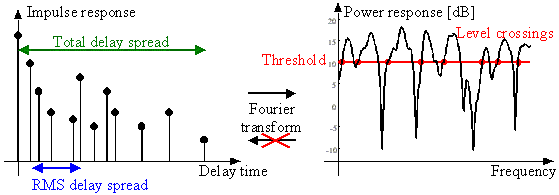 | Wireless CommunicationChapter: Wireless Propagation Channels |
Estimating the RMS Delay Spread
from the Frequency-Domain Level Crossing Rate
Contributed by Klaus Witrisal
The root-mean-square (RMS) delay spread is probably the most important
single measure for the delay time extent of a multipath radio channel.
Since the impulse response (IR) and the transfer function (TF) of a channel
are related by the Fourier transform, it is intuitively understandable
that the TF's magnitude shows more fades per bandwidth, the longer the
IR.

As shown by Witrisal et al. [2], [3], there exists a well-defined relationship between the so-called level crossing rate in the frequency-domain (LCRf) and the RMS delay spread (Trms), written as
LCRf = Trms * f(K, r', u). (1)
As seen from this equation, Trms and the LCRf are proportional, where the proportionality factor is a function of
- the Ricean K-factor K
- the threshold value at which the LCRf is determined, r' (r' is normlized to the RMS amplitude value of the TF)
- and the channel model, expressed by u. (This influence is very small, therefore it can be neglected [2].)
 .
.
Application to Channel Measurements
Equation (1) allows for the estimation of a complete set of wide-band channel parameters (average received power, Ricean K-factor, and RMS delay spread) from rather simple swept-frequency power measurements of the channel. (Note that the Fourier transform cannot be used to calculate an IR from a measured power response, due to the lack of phase information). The following measurement procedure is suggested:- Measure the narrowband power (or magnitude) response of the channel as a function of frequency. (A continuous wave frequency generator and a spectrum analyzer can be used to conduct such measurements).
- Calculate the average received power and the Ricean K-factor from the measured power response.
- Count the number of level crossings at a specific threshold, preferably at the RMS amplitude.
- Use equation (1) for estimating Trms.
Other issues that should be considered when applying this method for channel investigations are:
- Influence of the sampling interval of the channel's frequency response: The sampling interval must be selected according to the sampling theorem, otherwise some fades may be missed when counting the level crossings.
- Influence of measurement equipment noise: Noise may introduce additional level crossings, which would lead to overestimation of Trms. The sampling interval mentioned above should be as large as possible to minimize this effect
![]()
Wireless Communication ©
Klaus
Witrisal
Centre for Wireless Personal Communications (CEWPC)
TU-Delft, IRCTR
Mekelweg 4
NL-2628 CD Delft
The Netherlands
Phone: +31(0)15-27-87371
Fax: +31(0)15-27-84046
email: K.Witrisal@ITS.TUDelft.NL



